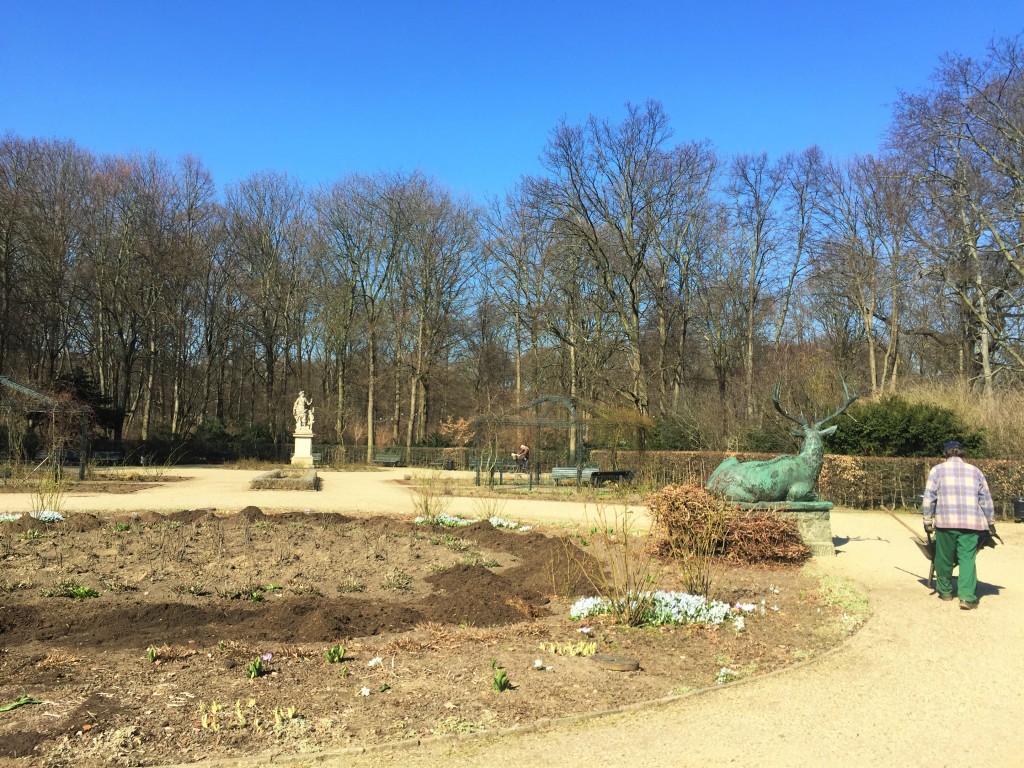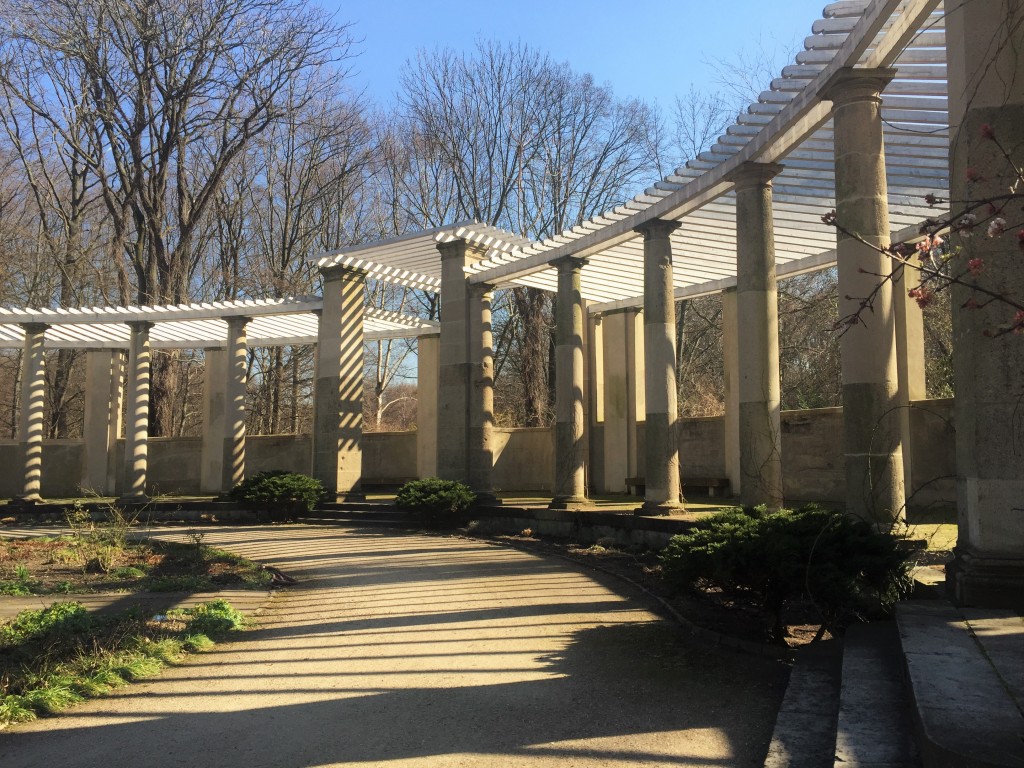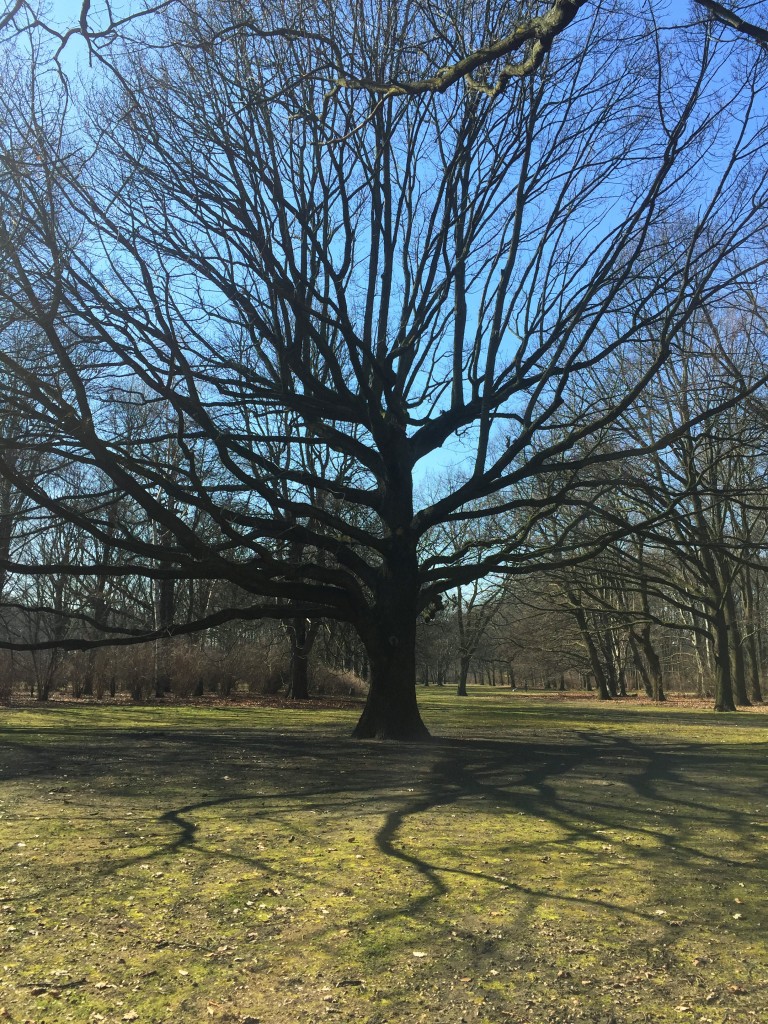Rosengarten
In 1909, the director of the Tiergarten, Felix Freudeman, in cooperation with the rose breeder Peter Lambert, created the Rosengarten. More than a third of the rose garden was lost in 1951 when the Bremer Web path was built. What remained after World War II was redesigned in 1974. As Lenné said, “the large park needs these jewels in order not to lose the most exquisite enjoyment of variety and surprise.”

Photos of the Rosengarten © Jasmine Welch
Old Trees
During the bombings of World War II, the majority of trees throughout the Tiergarten were destroyed. After the war had ended, what remaining trees left were cut down and used for construction or as firewood. With the reconstruction of the park came the preservation for the Tiergarten and the few “old” trees left standing. For 18 years, park officials have been looking after one of the oldest trees still standing. This perfectly healthy 350-year-old Oak tree has survived two wars and reaches 100 feet with a circumference of 12 feet.
Photo of a pre-war Oak tree © Jasmine Welch
Englischer Garten
Opened on May 29, 1952, the commandant of the British sector had initiated construction of the English Garden. The small and popular café, the Teehaus, was built to commemorate the former dairy created by Gilly in Schlosspark Bellevue.
Steppengarten
Created in 1953 by park director Willy Alverdes, the Steppengarten was completely replanted in 2009 and is maintained voluntary by the local parks, gardens and garden monuments authorities.
Grosser Hain
In the 19th century, Großer Hain, or big grove, received attention for being one of the main entrances into the Tiergarten. Lenné’s proposal design was the inspiration for its current layout. The grove laid close to the Berlin Wall’s border area, far away from visitor’s interests, but after the reunification of Germany in 1990, the Tiergarten was a choice for the government district, making the Großer Hain a highly frequented area.
Rousseau-Insel
In 1792, royal gardener Sello created the Neue Partie by expanding one of the waterways that drained the forest and formed a lake with several islands. One island was dedicated to the French philosopher Jean-Jacques Rousseau. In 1987, donations made it possible to replace the original lost monument with a new memorial stone.
Grossfürstenplatz
Prince Ferdinand, the youngest brother of King Frederick II, created a semi-circular square on the banks of the River Spree. To commemorate the engagement of the Grand Duke Paul, heir to the throne of Russia, to Princess Sophie Luise von Württemberg, the square was renamed Großfürstenplatz, Grand Duke Square, in 1776. Created during 1860 and 1870, four sandstone sculptures of the rivers Rhine, Elbe, Oder and Vistula, were erected in 1880, later complemented by a marble Triton fountain in 1888. Restorations began in 1987 and lasted until 2014.
Zeltenplatz and Haus der Kulturen der Welt
Designed by von Knobelsdorff in the mid-18th century, the Zeltenplatz, or Tent Square, with seven avenues named after the species of tree that was planted along them. The name came about when two canvas tents were set up to provide drinks to visitors. The canvas tents were later replaced by wooden huts, which were later replaced by solid buildings, used not only for recreation but for political gatherings, most notable the March Revolution in 1848. After the tents were destroyed during World War II, the Kongresshalle was built in 1957 by architect Hugh Stubbins, as a gift from the United States. Since 1989, the buildings have been used for the cultural venue, Haus der Kulturen der Welt, or as locals have nicknamed Schwangere Auster, pregnant oyster. In 1987, the Zeltenplatz was restored and the Carillon, a 42-meter tall musical tower, was erected to commemorate the chimes of the parish church and the Potsdam Garnisonkirche, both destroyed during World War II.
Kulturforum
The Kulturforum was established after WWII, when art was split, where the East had their own museum island and the West needed to house their cultural collections. Built by architect Hans Bernhard Scharoun, it includes the Philharmonie: first building opened in 1963 and home to Berlin Philharmonic Orchestra; Neue Nationalgalarie: opened in 1968, designed by Miles van der Rohe, most praised and a temple of light and glass; Museum of Musical Instruments: opened in 1984; Museum of Applied Arts: opened in 1985 and designed by Rolf Gutbrod; Picture Gallery: opened in 1998 and reunited European paintings that had been separated during the Cold War; Graphic Arts Museum: houses middle ages & renaissance; State Library 1967-1978; Art Library in 1990s; Hall of Chamber Music in 1980s; Science Center in 1988; St Matthews Church: constructed in the 19th century and designed by Friederich August Stuler and Herbert Wentzel.
Photo of the Kulturforum, Schloss Bellevue and the Tiergarten © Jasmine Welch
Schloss Bellevue
Built in the 18th century as a summer residence for the Prussian Prince August Ferdinand, it is now the official resident of the German President. Architect Philipp Daniel Boumann constructed the palace as the first neo-classical building in Berlin in 1786. Bellevue served as a royal palace until 1918, and after World War I, it was used for multiple purposes, like housing for the Third Reich and an ethnology museum. Bellevue was damaged during World War II, but restoration began in 1954 and was completed in 1959. Further restoration took place in the 1980’s, and Bellevue became the primary residence of the President after German reunification.
Berlin Zoological Garden
The Berlin Zoo was opened to the public in 1844 and is the oldest Zoo in Germany. It boasts almost 1,500 different species and more than 17,000 animals. The aquarium opened in 1913.


